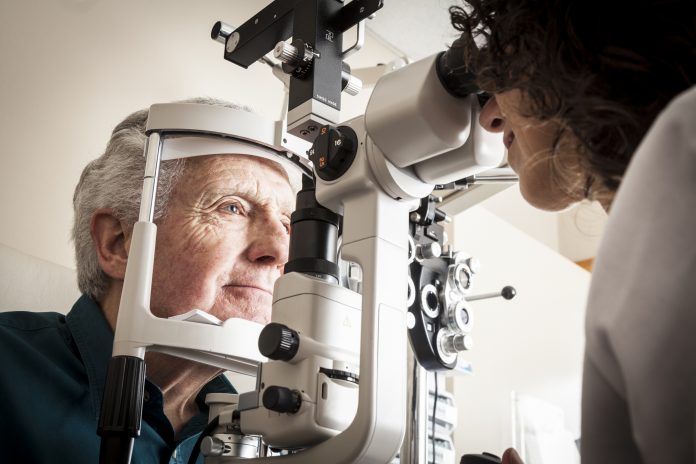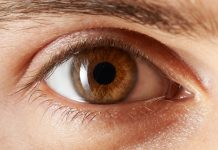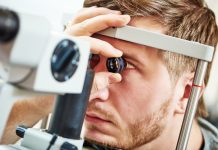Age-related macular degeneration is known to affect millions of people around the globe and is fourth on the list of diseases that commonly lead to blindness, behind cataracts, preterm birth and glaucoma
Macular degeneration, also called age-related macular degeneration (AMD), is a medical condition that results in blurred or total vision loss in the centre of a person’s visual field.
The macula is a small but extremely important area located at the retina’s centre; the retina is the light-sensing tissue that lines the back of the eye. It is this area that is responsible for seeing details clearly.
A person with macular degeneration will retain normal peripheral vision. For example, when looking at a clock, they may see the outside but not the time.
In the early stages of the disease, there are often no symptoms. An individual will usually experience a gradual loss of their vision. Loss of vision may affect either one or both eyes.
Although the condition will not necessarily lead to total vision loss, weak central vision can make daily activities difficult, and it will also make recognition of faces and objects more challenging. In addition to this, it is not uncommon for someone with AMD to experience hallucinations.
Two types of macular degeneration
There are two types of macular degeneration known as ‘wet’ and ‘dry’. Most cases of AMD are dry.
With dry macular degeneration, the blood vessels in the eye do not leak. There are usually minimal symptoms in the early stages; however, it progressively worsens as time goes on. Vision loss tends to occur within the intermediate to late stages.
Dry AMD usually affects both eyes; however, in cases where only one eye is affected, vision changes are more noticeable sooner as one eye starts to make up for the vision loss in the other.
Wet AMD is when abnormal blood vessels grow in the eye and leak below the macula, resulting in permanent vision loss. It is a more advanced form of AMD, and dry AMD can progress to wet AMD.
At what age does age-related macular degeneration usually begin?
The risk of macular degeneration increases with age and usually begins at 50 and over. However, in some rare instances, the disease affects younger people, called juvenile macular degeneration.
What causes age-related macular degeneration?
While the exact cause of AMD is unknown, several different risk factors can contribute to macular degeneration, including:
- Age – this disease is most common in people over 60.
- Genetics researchers have identified several genes that are related to developing the condition.
- Smoking – or being regularly exposed to smoke significantly increases your risk of macular degeneration.
- Obesity – can increase the chance of early or intermediate macular degeneration progressing to a more severe form of the disease.
- High blood pressure.
What are the symptoms of age-related macular disease?
The symptoms of macular degeneration are similar to other eye conditions, making it difficult to detect initially. Early AMD is usually asymptomatic, meaning symptoms won’t be noticeable. It’s advised you see an optician for diagnosis with an eye exam.
Symptoms may include any of the following:
• Decreased visual acuity.
• Difficulty distinguishing between colours and shades.
• Metamorphopsia – seeing a grid of straight lines as wavy or as having blank areas.
• Seeing blurry areas on a printed page.
• Hallucinations.
• Extra sensitivity to glare.
Does age-related macular degeneration get worse?
Age-related macular degeneration can get worse and affect your vision. AMD’s worsening can happen over several years or at a more rapid rate over a few weeks or months.
There is no treatment for dry AMD, but vision aids can help with lifestyle.
Wet AMD is usually treated with injections in the eye. These injections stop vision from worsening, but they will not recover visual acuity that has already been lost. Therefore, getting treatment as soon as possible is essential if you have been diagnosed with wet AMD.
How long does it take to lose vision with macular degeneration?
According to reports by the American Optometric Association, it can take around ten years for people with AMD to experience complete vision loss.
Those with dry AMD will lose their vision gradually as the retinal cells die off. On the other hand, wet forms of macular degeneration can cause your vision to deteriorate at a rapid rate. Some even lose their sight within days of having symptoms.
How is age-related macular degeneration treated?
There is no complete cure for AMD, although there are treatments that can slow the process. Different procedures are used to treat different types of AMD.
Treatment for dry AMD
There is no treatment for dry AMD; however, visual aids can keep your vision sharp and eyes safe from dry eye, thus reducing its effect. These include large, printed books, magnifying glasses, bright reading lights and smart screen reading software.
Treatment for wet AMD
Also known as neovascular AMD, wet AMD relies on medications called anti-vascular endothelial growth factor drugs for treatment. These stop blood vessel growth which leads to sight damage.
The medication gets injected into the vitreous: a gel-like substance inside the eye. Before the injection, the doctor will give you an anaesthetic drug to ease pain and an antibiotic drop to prevent infection.
Side effects include blurry vision for a short time after the injection. Injections are usually given in a course for one or a few months, at first.
Anti-VEGF medications have a high success rate. However, starting treatment as early as possible would be best as this treatment cannot repair underlying damage.
Occasionally Wet AMD is treated with ‘photodynamic therapy’, a light treatment that will prevent your vision problems from worsening.
Preventing age-related macular degeneration
It’s essential to have routine eye exams to identify early signs of macular degeneration. The following measures may help reduce your risk of developing dry macular degeneration:
- Managing your other medical conditions – for example, if you have cardiovascular disease or high blood pressure, take your medication and follow your doctor’s instructions for controlling the condition.
- Avoiding smoking – smokers are more likely to develop macular degeneration than non-smokers. Ask your doctor for help to stop smoking.
- Maintaining a healthy weight and exercising regularly – if you need to lose weight, reduce the number of calories you eat and increase the amount of exercise you get each day.
- Choosing a diet rich in fruits and vegetables – these foods contain antioxidant vitamins that reduce your risk of developing macular degeneration.
- Including fish in your diet – omega-3 fatty acids found in fish and nuts such as walnuts may reduce the risk of macular degeneration.
References
- A guide to blurry vision (https://www.feelgoodcontacts.com/eye-care-hub/a-guide-to-blurry-vision)
- A guide to cataracts (https://www.feelgoodcontacts.com/eye-care-hub/a-guide-to-cataracts)
- A guide to peripheral vision loss (https://www.feelgoodcontacts.com/eye-care-hub/a-guide-to-peripheral-vision)











